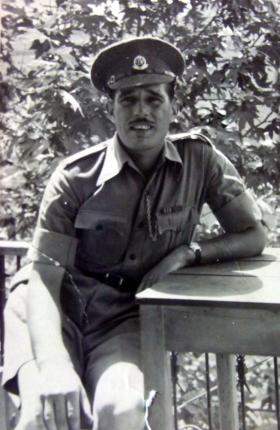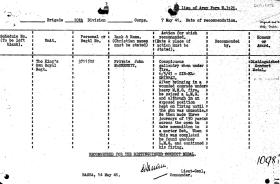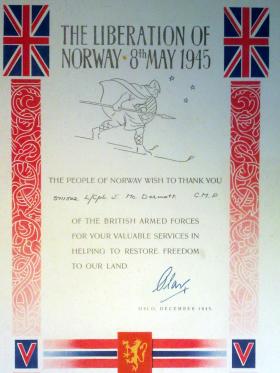Private John L McDermott, enlisted into The King's Own Royal Regiment (Lancaster) as a 16 year old in 1936. He served with them in Palestine from 1936 to 1939 and in Iraq in 1941.
He was recommended for a Distinguished Conduct Medal, but awarded a Military Medal, for conspicuous gallantry in August 1941, when he carried a wounded comrade under heavy enemy fire and also made repeated runs across open ground to resupply a mortar detachment with ammunition.
In 1942 Pte McDermott transferred to the Corps of Military Police. He qualified as a military parachutist on Course 137 at RAF Ringway on 9 to 23 October 1944 and was posted to 6th (Airborne) Divisional Provost Company CMP.
Pte McDermott married Private Vivien Hall in November 1944, shortly after she had returned from serving overseas for several months.
He was transferred to 1st Airborne Division Provost Company and deployed to Norway in May 1945 for Operation Doomsday.
Compiled with the assistance of Isobel Davies
Read More



Latest Comments
John Lawrence McDermott was born on 8th June 1920 at Blackpool, the son of Lawrence and Margaret (nee Coxhall). His birth was registered in the fourth quarter of 1920 in the Registration District of Fylde, Lancashire.
McDermott enlisted into The King’s Own Royal Regiment (Lancaster) as a 16 year old in 1936, and was posted to the 2nd Battalion serving with them in Palestine, being awarded the General Service Medal with clasp, ‘Palestine’.
On the outbreak of the Second World War, the 2nd Battalion King’s Own Royal Regiment was still stationed in Palestine whilst the 1st Battalion was based at Karachi, India. The date of McDermott’s transfer to the 1st Battalion is unknown, but on 15th April 1941, he was one of the 14 officers and 350 men of the battalion who flew out of Karachi, bound for Iraq where a pro-German coupe had taken place led by Rachid-Ali Ghailiani as Prime Minister.
The battalion arrived at RAF Habbaniya on 23rd April 1941, and was deployed as mobile reserve to consolidate the defence of the airfield which was under threat of attack from Iraqi forces. Reconnaissance and fighting patrols were pushed out every night, but on 6th May, an attack of battalion strength was ordered after reports that the strength of the Iraqi forces was not as great as first thought.
The Regimental History takes up the story as follows: ‘In this operation, the battalion was to be preceeded by RAF armoured cars which were to sweep the area before the infantry attacked. ‘D’ Company under Clayton was directed on Dibban village while ‘B’ Company under Captain Gribbon moved round to the right. Not a shot was fired at the armoured cars, so Clayton advanced with his company and came almost up to the village where, contrary to expectation, the enemy was found to be well dug in and camouflaged and in great numerical strength. He reserved his fire until the King’s Own was almost on him and then opened up with everything he had, both from the rocks nearby and from the village itself. Lieutenant J. Thompson approached an enemy machine gun nest which he covered with his pistol as he called upon the crews to surrender. As they raised their hands he lowered his pistol, but one of the Iraqis pressed the thumb-piece of his gun and killed Thompson outright. Not one of the enemy left that place alive. Weir seized a light machine gun with which he forced the Iraqis to keep their heads down and so he made possible the withdrawal of his company…Private J. McDermott brought in one wounded man under heavy fire so long as it worked. Then he found another light machine gun and carried on. Later he made three separate journeys across a bullet-swept area to carry ammunition to a mortar detachment. Sewage Farm possessed a telephone so that it was possible to report the position as soon as Clayton got back there himself. His company remained there under heavy fire, but fortunately inaccurate machine-gun fire. Its casualties amounted to four men killed and four wounded’.
For his gallant conduct during this action, McDermott was afterwards awarded the Military Medal, the award being announced in the London Gazette dated 19th August 1941. The official recommendation which was for a DCM, is as follows: ‘For conspicuous gallantry when under fire, 6/5/41 SIN-EL-DHIBBAN. After bringing in a wounded comrade under heavy M.M.G. fire, he seized a L.M.G. and although in an exposed position kept on firing until the gun was unusable. He then made three journeys of 150 yards across the open to take ammunition to a mortar Det. When this was completed he found another L.M.G. and continued his firing’.
A letter written by McDermott’s Company Commander, Captain David Clayton provides further details of the action: ‘On 5th May, ‘D’ Company carried out a patrol to capture Iraqi prisoners from their positions on the heights surrounding our garrison penned in Habbinaya (sic). This achieved some success and a few prisoners were captured. On 6th May, my Company, ‘D’ Coy, were directed to attack Dibban village, which the R.A.F. had reported only lightly held. Contrary to this report, the enemy was found to be well dug in and camouflaged and in great numerical strength. They reserved their fire until we were almost on them, and then opened up with everything. The Company had to withdraw. A difficult operation largely assisted by Captain Weir manning a light machine gun. McDermott brought in one wounded man under heavy fire. He then returned to the battle, found a machine gun which he continued to fire covering the Company withdrawal until he ran out of ammunition. He then picked up a light machine (gun) and continued to return enemy fire. Later he made three separate sorties across a bullet swept area to carry ammunition to a mortar detachment whose fire was vital to the withdrawal of ‘D’ Company. I was with McDermott part of the time and considered his M.M. more than fully deserved. Have heard nothing of McDermott since 1955 when he was in Lancaster’…Signed: David Clayton (February 1983).
The following May 1942, the 1st Battalion transferred to the Western Desert and fought with distinction before suffering heavy casualties in the break-out from Mersa Matruh on 29th June 1942. The remaining survivors of the battalion left Alexandria aboard the troopship HMT Princess Marguerite en route for Cyprus when the ship was sunk by enemy submarine on 17th August 1942, losing one officer and 23 other ranks drowned.
The battalion eventually reached Cyprus on 27th August 1942, where it was amalgamated with two other depleted battalions, the 1st Battalion Duke of Cornwall’s Light Infantry and the 1st Battalion South Wales Borderers, the resulting unit taking the name of the senior regiment i.e. The King’s Own Royal Regiment. A period of training in Cyprus, Syria and Palestine followed, before the battalion was sent to the island of Leros on 5th November 1942 to strengthen the Italian Garrison following the capitulation of Italy. On 12th November, the island was the subject of a major seaborne and airborne invasion, supported by persistent aerial machine gunning and bomb attacks from Stuka bombers. The island surrendered on 16th November, and the majority of the garrison were taken prisoner. One officer and 57 other ranks from the King’s Own escaped and rejoined the details in Palestine. The battalion was later reconstituted by absorbing the 8th Battalion King’s Own.
At some point in 1942, McDermott transferred into the Corps of Military Police, and qualified as a military parachutist on Course 137 at RAF Ringway between 9th-23rd October, 1944. Initially posted to the 6th (Airborne) Division Provost Company CMP, he later transferred to 1st (Airborne) Division Provost Company where he was deployed to Norway in May 1945 with ‘Operation Doomsday’. He afterwards received a certificate ‘The Liberation of Norway 8th May 1945’, named to him as ‘3711502 L. Cpl J. McDermott C.M.P.’
John McDermott married Vivien Hall at Westminster, London, in November 1944. In 1949, he re-married a Hazel Hamlin and changed his surname to ‘Crowder’, the name of his stepfather; his mother having remarried a James Crowder in 1933 shortly after McDermott’s father had died. McDermott’s entry on the GSM Palestine Medal Roll is annotated ‘now Crowder’ and confirms that a replacement General Service Medal, presumably named ‘J. Crowder’ was issued on 13th February 1976.
John McDermott (Crowder) is listed in the telephone directories up until 1984 as a Market Gardener living at White Cottage, Division Lane, Marton Moss, Blackpool. Crowder Nurseries is still a trading company, and the owner of the business recollects that ‘Jack had a drawer full of medals, and that he was in the Commandos. He is quoted as saying that the Army was the best years of his life’. John McDermott (Crowder) died at Lancaster in 1989, aged 68 years.
Add Comment
In order to add comments you must be registered with ParaData.
If you are currently a ParaData member please login.
If you are not currently a ParaData member but wish to get involved please register.